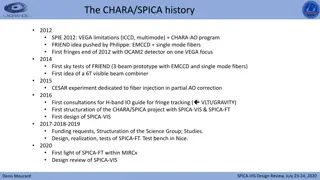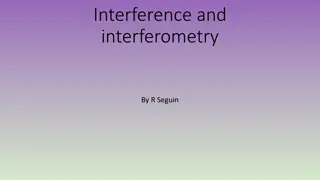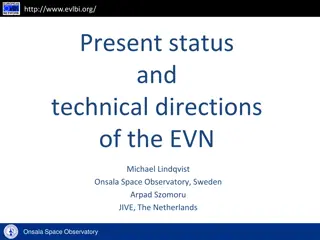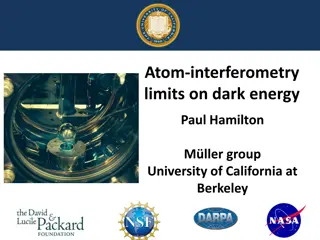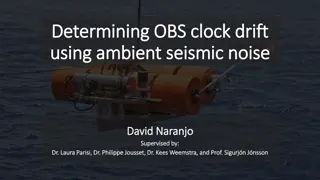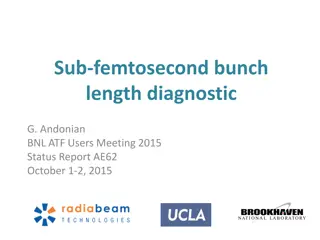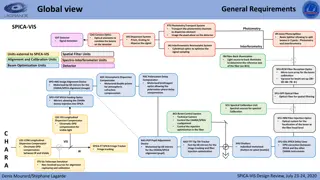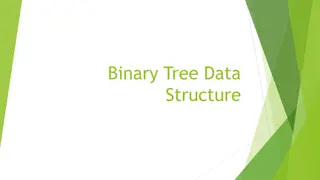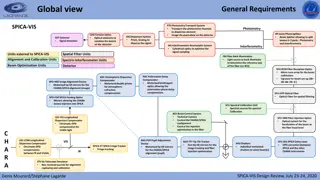Development of CHARA/SPICA Project for Stellar Astrophysics Research
CHARA/SPICA project history spans from funding requests to the realization of SPICA instruments, including SPICA-FT and SPICA-VIS. Scientific requirements focus on stellar physics, visible interferometry, and large surveys for stellar parameters determination, with detailed specifications for fringe
0 views • 6 slides
Light Interference and Interferometry
Discover the fascinating world of light interference and interferometry through examples like Young's double slit experiment and supernumerary rainbows. Understand how the path length difference affects interference levels and delve into the applications of interferometry across various scientific f
0 views • 12 slides
Overview of European Very Long Baseline Interferometry Network (EVN)
The European Very Long Baseline Interferometry Network (EVN) is a collaborative effort among major institutes in Europe to conduct advanced astronomical observations using a network of radio telescopes. The EVN, established in 1980, facilitates innovative research through effective collaboration, te
0 views • 23 slides
Limits on Dark Energy Using Atom Interferometry - UC Berkeley Study
Research conducted by Paul Hamilton Müller's group at the University of California, Berkeley, focuses on using atom interferometry to explore dark energy. The study delves into screened scalar fields as dark energy, future reach with atom interferometry, known unknowns related to dark energy densit
2 views • 39 slides
Determining OBS Clock Drift Using Seismic Interferometry
Determining clock errors in Ocean Bottom Seismometers (OBSs) is crucial for accurate seismic data recording. This study presents a method using ambient seismic noise and seismic interferometry to correct clock drift in OBSs. The program developed employs Python/Fortran to analyze seismic data direct
1 views • 10 slides
Detecting Gravitational Waves with Interferometers
Gravitational waves, predicted by Einstein's Theory of General Relativity, are incredibly weak ripples in spacetime that can be detected using interferometers. This method involves using suspended mirrors to reproduce free-fall conditions, enhancing signals through various techniques like Michelson
1 views • 23 slides
Sub-femtosecond Bunch Length Diagnostic and Machine Performance Optimization
Characterizing bunch profiles of sub-ps pulses for machine performance optimization and understanding beam variations in emittance. Current bunch length measurement techniques are limited to a few fs, prompting the need for femtosecond resolution. Techniques like Coherent Radiation Interferometry an
0 views • 15 slides
SPICA-VIS Photometry Transport System Overview
This detailed overview outlines the intricate components of the SPICA-VIS photometry transport system, including modules for photometry, interferometry, dispersion, signal detection, and more. Key elements such as the optical fiber feeding optics, polarization delay compensator, atmospheric dispersi
0 views • 21 slides
Studying Wolf-Rayet Stars: The Spectroscopic and Visual Orbit of WR 138
Wolf-Rayet (WR) stars are evolved, massive stars with their outer hydrogen envelopes stripped away, leading to strong stellar winds. Understanding these nitrogen-rich, carbon-rich, and oxygen-rich WR stars is crucial in unraveling their formation and contribution to nebula creation. This research de
1 views • 10 slides
Visible Instrument for Interferometry in Massive Stars Study
This collection of images and data explores various aspects of Massive Stars, including topics like stellar surface studies, multiplicity, circumstellar environments, scientific production, VEGA targets, and limitations. The content delves into measurements of stellar surfaces and discusses the chal
0 views • 26 slides
Binary Tree Data Structure
Proton holography explores phase reconstruction in elastic proton-proton scattering and binary stars through Levy expansion, convergence properties, and model-independent concepts. The research, presented at conferences in Hungary, delves into formalisms, abilities, and conclusions drawn from the st
0 views • 8 slides
Planetary Radio Interferometry and Doppler Experiment (PRIDE) Analysis
Investigate the scintillation of radio signals from VEX and MEX in interplanetary and ionospheric plasma. Explore data processing, target missions, and spacecraft interactions through PRIDE. Analyze orbital perturbations, atmospheric drag campaigns, and gravity coefficients. Collaborate with VLBI ne
0 views • 12 slides
Light Interference and Interferometry Overview
Light interference occurs when two waves of light converge, causing changes in what we see, similar to sound interference. Examples include double slit experiments and supernumerary rainbows. Interferometry, a scientific technique utilizing electromagnetic wave interference, is a widely used method
0 views • 14 slides
Understanding Light Interference and Interferometry
Explore the fascinating concepts of light interference, including examples like the double slit experiment and thin film interference. Discover how interferometry is used in various scientific fields to collect valuable data from electromagnetic waves.
0 views • 14 slides
Quantum Channel Estimation and Optimization for Lossy Interferometry
Explore the latest research on quantum channel estimation and optimization, including topics like input probe incompatibility, measurement incompatibility, and correlated estimators. Discover the advancements in multiple-phase lossy interferometry and adaptive schemes in this field.
0 views • 12 slides
Understanding Aperture Synthesis in Radio Astronomy
Explore the concepts of Aperture Synthesis in Radio Astronomy and Interferometry, where signals from multiple antenna elements are combined to enhance resolution and sensitivity. Learn how measurements are made, the basic principles behind Aperture Synthesis, and the benefits it offers in astronomic
0 views • 18 slides
Advanced Optical System for SPICA-VIS Photometry and Interferometry
Explore the detailed components of the SPICA-VIS photometry and interferometry system, including beam splitters, prism dispersion, signal detection, fiber optics, calibration units, and more, designed for precise astronomical observation.
0 views • 21 slides
Quantum Channel Optimization and Interferometry Research Overview
Explore recent research in quantum channel optimization and interferometry, covering topics such as input probe incompatibility, measurement incompatibility, correlated estimators, and advancements in LIGO/VIRGO noise reduction through squeezing. Discover the latest findings and developments in the
0 views • 18 slides
